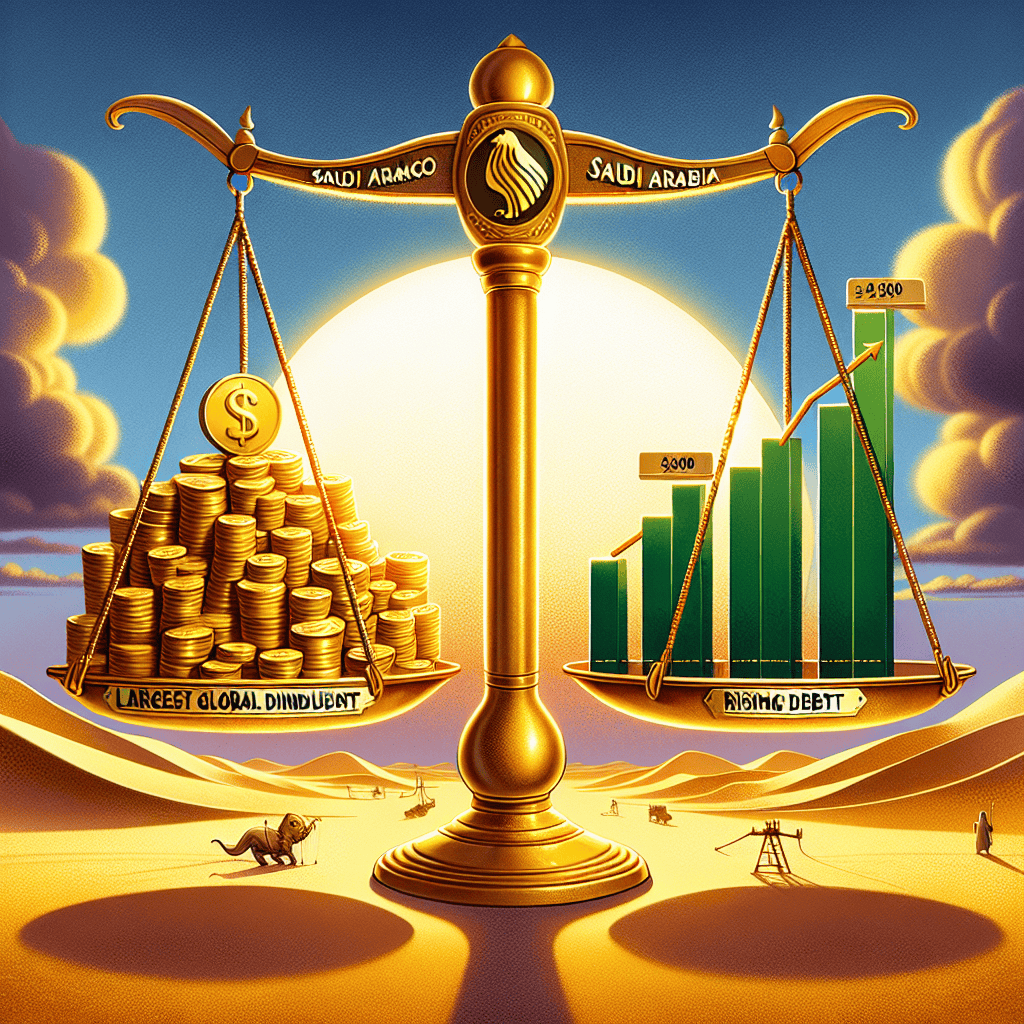“Saudi Aramco: Leading Dividends, Defying Debt.”
Introduction
Saudi Aramco, the world’s largest oil company, has upheld its position as the leading global dividend payer, even as it navigates the challenges of rising debt levels. The state-owned energy giant, pivotal to Saudi Arabia’s economy, has consistently prioritized shareholder returns, reflecting its commitment to maintaining investor confidence and supporting the kingdom’s fiscal objectives. Despite the financial pressures from fluctuating oil prices and increased borrowing, Aramco’s robust dividend policy underscores its strategic focus on long-term growth and financial stability. This approach not only reinforces its stature in the global energy market but also aligns with Saudi Arabia’s broader economic diversification goals under the Vision 2030 initiative.
Impact Of Rising Debt On Saudi Aramco’s Financial Strategy
Saudi Aramco, the world’s largest oil company, has consistently maintained its position as a financial powerhouse, largely due to its ability to distribute substantial dividends to its shareholders. Despite the challenges posed by fluctuating oil prices and global economic uncertainties, the company has managed to uphold its status as the largest global dividend payer. However, this commitment to generous shareholder returns has not come without its financial implications, particularly in the form of rising debt levels. As Saudi Aramco navigates this complex financial landscape, it is crucial to examine the impact of its increasing debt on its overall financial strategy.
To begin with, Saudi Aramco’s decision to maintain its dividend payouts, even in the face of rising debt, underscores its strategic priority of ensuring shareholder satisfaction. This approach is deeply rooted in the company’s broader economic role within Saudi Arabia, where dividends play a significant part in funding the government’s budget and supporting its ambitious Vision 2030 initiative. By continuing to provide substantial dividends, Saudi Aramco not only reinforces investor confidence but also contributes to the nation’s economic stability. Nevertheless, this strategy necessitates a careful balancing act between rewarding shareholders and managing financial liabilities.
The increase in Saudi Aramco’s debt can be attributed to several factors, including the need to finance capital-intensive projects and acquisitions aimed at diversifying its portfolio and enhancing its long-term growth prospects. For instance, the company’s acquisition of a majority stake in SABIC, a leading petrochemical firm, was a strategic move to expand its downstream operations. While such investments are essential for future growth, they inevitably lead to higher debt levels, which could potentially strain the company’s financial resources if not managed prudently.
Moreover, the global energy landscape is undergoing a significant transformation, with a growing emphasis on sustainability and the transition to cleaner energy sources. This shift presents both challenges and opportunities for Saudi Aramco. On one hand, the company must invest in new technologies and infrastructure to remain competitive in a low-carbon future. On the other hand, these investments require substantial capital, further contributing to the company’s debt burden. As a result, Saudi Aramco must carefully evaluate its investment priorities to ensure that it can meet its financial obligations while positioning itself for long-term success.
In light of these considerations, Saudi Aramco’s financial strategy must be adaptive and forward-looking. The company has already taken steps to optimize its operations and improve efficiency, which are crucial for maintaining profitability in a volatile market. Additionally, Saudi Aramco’s access to global capital markets provides it with the flexibility to manage its debt effectively. By leveraging its strong credit rating and investor confidence, the company can secure favorable financing terms, thereby mitigating the impact of rising debt on its financial health.
In conclusion, while Saudi Aramco’s commitment to maintaining the largest global dividend is a testament to its financial strength and strategic priorities, it also highlights the challenges associated with rising debt levels. The company’s ability to navigate these challenges will depend on its capacity to balance shareholder returns with prudent financial management and strategic investments. As Saudi Aramco continues to adapt to the evolving energy landscape, its financial strategy will play a pivotal role in ensuring its long-term sustainability and success.
Analyzing Saudi Aramco’s Commitment To Shareholders Amid Financial Challenges
Saudi Aramco, the world’s largest oil company, has consistently demonstrated its commitment to shareholders by maintaining the largest global dividend, even in the face of rising debt. This steadfast dedication to shareholder returns is a testament to the company’s strategic priorities and financial resilience. However, it also raises questions about the sustainability of such a policy amid fluctuating oil prices and increasing financial obligations.
To understand Saudi Aramco’s approach, it is essential to consider the broader context of the global energy market. The company operates in a highly volatile industry, where geopolitical tensions, regulatory changes, and shifts in demand can significantly impact financial performance. Despite these challenges, Saudi Aramco has managed to uphold its dividend policy, which is a crucial component of its value proposition to investors. This commitment is particularly noteworthy given the company’s substantial capital expenditure requirements and the ongoing transition towards renewable energy sources.
One of the primary reasons Saudi Aramco can maintain its dividend is its unparalleled production capacity and low-cost operations. The company possesses vast reserves and benefits from economies of scale, allowing it to produce oil at a lower cost than many of its competitors. This cost advantage provides a buffer against market fluctuations, enabling Saudi Aramco to generate substantial cash flow even when oil prices are not at their peak. Consequently, the company can allocate a significant portion of its earnings to dividends without compromising its operational capabilities.
However, the decision to prioritize dividends has not come without financial implications. Saudi Aramco’s debt levels have been rising, partly due to its commitment to maintaining high dividend payouts. The company has taken on additional debt to finance its capital expenditures and acquisitions, such as the purchase of a majority stake in SABIC, a leading petrochemical company. While these strategic investments are aimed at diversifying revenue streams and enhancing long-term growth prospects, they also contribute to the company’s growing financial obligations.
In light of these challenges, Saudi Aramco’s management has emphasized the importance of balancing shareholder returns with financial prudence. The company has implemented cost-cutting measures and efficiency improvements to optimize its operations and preserve cash flow. Additionally, Saudi Aramco is exploring opportunities in the renewable energy sector, recognizing the need to adapt to the global shift towards sustainable energy solutions. These initiatives are designed to ensure that the company remains competitive and financially robust in the long term.
Moreover, Saudi Aramco’s commitment to its dividend policy reflects its strategic alignment with the interests of its major shareholder, the Saudi Arabian government. The dividends provide a significant source of revenue for the government, supporting its economic diversification efforts and social programs. This alignment underscores the broader economic and political considerations that influence the company’s financial decisions.
In conclusion, Saudi Aramco’s ability to maintain the largest global dividend amid rising debt highlights its strategic priorities and financial resilience. While the company’s commitment to shareholder returns is commendable, it also necessitates careful management of financial risks and a proactive approach to navigating the evolving energy landscape. As Saudi Aramco continues to balance these competing demands, its future success will depend on its ability to adapt to changing market dynamics while upholding its value proposition to shareholders.
The Role Of Global Dividends In Saudi Aramco’s Market Position
Saudi Aramco, the world’s largest oil company, has consistently maintained its position as a leader in the global energy market, not only through its vast oil reserves and production capabilities but also by offering the largest global dividend. This strategic financial decision plays a crucial role in reinforcing its market position, even as the company faces rising debt levels. The decision to maintain such a substantial dividend is not merely a reflection of its financial health but also a strategic maneuver to ensure investor confidence and market stability.
In the competitive landscape of the global energy sector, dividends serve as a significant tool for attracting and retaining investors. For Saudi Aramco, the commitment to providing the largest global dividend underscores its dedication to shareholder value, which is a critical component of its market strategy. By offering substantial returns to its investors, Aramco not only enhances its attractiveness as an investment but also solidifies its reputation as a reliable and stable entity in an industry often characterized by volatility.
However, maintaining such a high dividend payout comes with its challenges, particularly in the context of rising debt. The company has had to navigate the delicate balance between rewarding shareholders and managing its financial obligations. Despite these challenges, Aramco’s decision to uphold its dividend policy reflects its confidence in its long-term financial strategy and its ability to generate sufficient cash flow to meet both its operational needs and shareholder expectations.
The rising debt levels, while a concern, are not unique to Saudi Aramco. Many companies in the energy sector have faced similar financial pressures, exacerbated by fluctuating oil prices and global economic uncertainties. Nevertheless, Aramco’s robust financial framework and strategic investments in technology and infrastructure have positioned it to manage these challenges effectively. By leveraging its vast resources and operational efficiencies, the company aims to sustain its dividend policy without compromising its financial stability.
Moreover, the role of global dividends in Aramco’s market position extends beyond immediate financial returns. It also serves as a signal of the company’s long-term vision and commitment to growth. By maintaining its dividend, Aramco communicates its confidence in its future prospects and its ability to navigate the complexities of the global energy market. This assurance is particularly important for investors who seek stability and predictability in their investments.
In addition to reinforcing investor confidence, the dividend policy also plays a strategic role in supporting Saudi Arabia’s broader economic objectives. As a key contributor to the national economy, Aramco’s financial health and stability have significant implications for the country’s economic development and diversification efforts. By maintaining its dividend, Aramco not only supports its shareholders but also contributes to the economic stability and growth of Saudi Arabia.
In conclusion, Saudi Aramco’s decision to maintain the largest global dividend, despite rising debt, is a testament to its strategic foresight and commitment to shareholder value. This approach not only strengthens its market position but also underscores its role as a pivotal player in the global energy sector. Through careful financial management and strategic investments, Aramco continues to navigate the challenges of the industry while reinforcing its reputation as a stable and reliable entity. As the company moves forward, its dividend policy will remain a key component of its strategy to sustain investor confidence and support its long-term growth objectives.
How Saudi Aramco Balances Debt And Dividend Payouts

Saudi Aramco, the world’s largest oil company, has consistently maintained its position as the leading global dividend payer, even as it navigates the complexities of rising debt. This balancing act between sustaining substantial dividend payouts and managing increasing financial obligations is a testament to the company’s strategic financial management and its commitment to shareholder value. As the global energy landscape evolves, Saudi Aramco’s approach to balancing debt and dividends offers insights into its long-term vision and operational resilience.
To understand how Saudi Aramco manages this delicate balance, it is essential to consider the company’s financial structure and strategic priorities. The oil giant’s ability to maintain its dividend payouts, despite fluctuations in oil prices and market conditions, is rooted in its robust cash flow generation. Saudi Aramco’s vast oil reserves and low production costs provide a steady revenue stream, enabling the company to support its dividend commitments. This financial strength is further bolstered by its strategic investments in downstream and petrochemical sectors, which diversify its income sources and mitigate risks associated with oil price volatility.
However, the commitment to maintaining high dividend payouts has not come without challenges. The global energy market has experienced significant disruptions, from geopolitical tensions to the transition towards renewable energy sources. These factors have exerted pressure on oil prices, impacting revenue streams. In response, Saudi Aramco has strategically leveraged debt to finance its operations and investments, ensuring that it can continue to meet its dividend obligations while pursuing growth opportunities. This approach reflects a calculated risk, as the company balances the benefits of debt financing against the potential long-term implications of increased financial leverage.
Moreover, Saudi Aramco’s financial strategy is closely aligned with the broader economic objectives of Saudi Arabia. The company’s dividends play a crucial role in supporting the Saudi government’s fiscal budget, given that the state is the majority shareholder. This relationship underscores the importance of maintaining dividend stability, not only for the company’s shareholders but also for the national economy. Consequently, Saudi Aramco’s financial decisions are often influenced by broader economic considerations, including the need to support public spending and economic diversification initiatives under Saudi Vision 2030.
In addition to its financial strategies, Saudi Aramco’s operational efficiency and technological innovation contribute to its ability to balance debt and dividends. The company continuously invests in advanced technologies and sustainable practices to enhance its production efficiency and reduce costs. These efforts not only improve profitability but also position Saudi Aramco as a leader in the transition towards more sustainable energy solutions. By optimizing its operations, the company can generate sufficient cash flow to service its debt and maintain its dividend payouts, even in challenging market conditions.
In conclusion, Saudi Aramco’s ability to maintain the largest global dividend amidst rising debt is a reflection of its strategic financial management, operational efficiency, and alignment with national economic goals. The company’s approach to balancing these elements demonstrates its resilience and adaptability in a rapidly changing energy landscape. As Saudi Aramco continues to navigate the complexities of the global market, its commitment to shareholder value and economic stability remains a central pillar of its corporate strategy. Through prudent financial management and strategic investments, Saudi Aramco is well-positioned to sustain its leadership in the global energy sector while fulfilling its dividend commitments.
The Economic Implications Of Saudi Aramco’s Dividend Policy
Saudi Aramco, the world’s largest oil company, has consistently maintained its position as the leading global dividend payer, a strategy that has significant economic implications. Despite the challenges posed by fluctuating oil prices and rising debt levels, the company has remained committed to its generous dividend policy. This approach not only underscores Aramco’s financial resilience but also highlights the broader economic strategies of Saudi Arabia, which relies heavily on oil revenues to fund its national budget and ambitious economic diversification plans.
The decision to uphold such a substantial dividend payout, even in the face of increasing debt, reflects Aramco’s strategic priorities. By ensuring a steady flow of dividends, the company provides a crucial source of income for the Saudi government, which owns a majority stake in Aramco. This income is vital for funding Vision 2030, Saudi Arabia’s comprehensive plan to diversify its economy away from oil dependency. The dividends serve as a financial backbone, supporting investments in infrastructure, tourism, and technology sectors, which are pivotal to the kingdom’s long-term economic transformation.
However, maintaining high dividend payouts amidst rising debt levels raises questions about the sustainability of this approach. Aramco’s debt has been increasing as the company invests in expanding its production capacity and acquiring assets to strengthen its market position. While these investments are essential for future growth, they also contribute to the company’s financial liabilities. Balancing the need for investment with the commitment to high dividends presents a complex challenge, as it requires careful financial management to avoid compromising the company’s long-term stability.
Moreover, the global energy landscape is undergoing significant changes, with increasing emphasis on renewable energy sources and a gradual shift away from fossil fuels. This transition poses additional challenges for Aramco, as it must navigate the evolving market dynamics while maintaining its profitability and dividend commitments. The company’s ability to adapt to these changes will be crucial in determining its future success and, by extension, the economic stability of Saudi Arabia.
In this context, Aramco’s dividend policy can be seen as a double-edged sword. On one hand, it provides immediate financial benefits to the Saudi government and supports national economic goals. On the other hand, it may limit the company’s financial flexibility, potentially hindering its ability to invest in new technologies and adapt to the changing energy landscape. Therefore, it is imperative for Aramco to strike a balance between rewarding its shareholders and ensuring its long-term viability.
Furthermore, the implications of Aramco’s dividend policy extend beyond Saudi Arabia’s borders. As a major player in the global oil market, Aramco’s financial strategies can influence oil prices and, consequently, the economies of other oil-producing nations. By maintaining high dividends, Aramco signals confidence in its financial health, which can stabilize market perceptions and contribute to global economic stability.
In conclusion, Saudi Aramco’s commitment to maintaining the largest global dividend amidst rising debt levels reflects a strategic choice with far-reaching economic implications. While it supports Saudi Arabia’s immediate financial needs and long-term economic goals, it also presents challenges that require careful navigation. As the global energy landscape continues to evolve, Aramco’s ability to adapt while upholding its dividend policy will be a critical factor in shaping both its future and the broader economic landscape.
Comparing Saudi Aramco’s Dividend Strategy With Other Oil Giants
Saudi Aramco, the state-owned oil giant of Saudi Arabia, has consistently maintained its position as the world’s largest dividend payer, a strategy that has drawn considerable attention in the global energy sector. Despite the challenges posed by fluctuating oil prices and rising debt levels, Aramco’s commitment to its dividend policy remains unwavering. This steadfast approach sets it apart from other major oil companies, which have often adjusted their dividend strategies in response to market conditions.
In the context of the global oil industry, dividends are a critical component of shareholder returns, serving as a signal of financial health and stability. For Saudi Aramco, the decision to uphold its substantial dividend payouts is deeply intertwined with the economic objectives of the Saudi government, which relies heavily on these payments to fund its national budget and ambitious Vision 2030 economic diversification plan. Consequently, Aramco’s dividend strategy is not merely a financial decision but a reflection of broader national priorities.
Comparatively, other oil giants such as ExxonMobil, Royal Dutch Shell, and BP have adopted more flexible dividend policies. These companies have historically adjusted their dividends in response to market volatility, prioritizing financial prudence and balance sheet strength. For instance, during periods of low oil prices, these firms have often opted to cut or suspend dividends to preserve cash flow and maintain investment in future projects. This approach allows them to navigate economic downturns more effectively, albeit at the cost of immediate shareholder returns.
The divergence in dividend strategies between Saudi Aramco and its peers can be attributed to several factors. Firstly, Aramco’s unique ownership structure, with the Saudi government as its primary shareholder, aligns its dividend policy with national fiscal needs rather than solely focusing on market-driven financial metrics. In contrast, publicly traded companies like ExxonMobil and Shell must balance shareholder expectations with financial sustainability, often leading to more conservative dividend policies.
Moreover, Aramco’s vast oil reserves and low production costs provide it with a competitive advantage, enabling it to generate substantial cash flows even in challenging market conditions. This financial resilience supports its ability to maintain high dividend payouts, despite rising debt levels. However, this strategy is not without risks. The increasing debt burden could potentially constrain Aramco’s financial flexibility in the long term, particularly if oil prices remain volatile or decline.
In contrast, other oil majors have increasingly focused on diversifying their energy portfolios, investing in renewable energy and low-carbon technologies to mitigate the risks associated with fossil fuel dependency. This strategic shift reflects a broader industry trend towards sustainability and long-term resilience, which may influence future dividend policies. By prioritizing investment in new energy sources, these companies aim to secure their financial future while addressing growing environmental concerns.
In conclusion, Saudi Aramco’s commitment to maintaining the world’s largest dividend highlights a distinctive approach within the oil industry, driven by national economic imperatives and its unique market position. While this strategy has successfully supported Saudi Arabia’s fiscal goals, it also underscores the potential challenges of balancing high dividend payouts with rising debt levels. As the global energy landscape continues to evolve, the contrasting dividend strategies of Aramco and its peers will remain a focal point for industry observers, offering insights into the diverse ways oil companies navigate financial and strategic priorities.
Future Prospects For Saudi Aramco’s Dividend Sustainability
Saudi Aramco, the world’s largest oil company, has consistently maintained its position as the leading global dividend payer, a status it has upheld even amidst rising debt levels. This commitment to shareholder returns is a testament to the company’s robust financial strategy and its pivotal role in the global energy market. However, the sustainability of such generous dividends in the face of increasing financial obligations raises pertinent questions about the future prospects of Saudi Aramco’s dividend policy.
To understand the sustainability of Saudi Aramco’s dividends, it is essential to consider the company’s financial health and strategic priorities. Despite the challenges posed by fluctuating oil prices and global economic uncertainties, Saudi Aramco has demonstrated remarkable resilience. The company’s ability to generate substantial cash flow from its operations has been a key factor in maintaining its dividend commitments. This financial strength is underpinned by its vast oil reserves and efficient production capabilities, which enable it to remain profitable even when market conditions are less than favorable.
Moreover, Saudi Aramco’s strategic investments in downstream and petrochemical sectors have diversified its revenue streams, providing a buffer against the volatility of crude oil prices. These investments not only enhance the company’s value chain but also contribute to its long-term financial stability. As a result, Saudi Aramco is better positioned to sustain its dividend payouts, even as it navigates the complexities of the global energy landscape.
Nevertheless, the rising debt levels cannot be overlooked. The company’s increasing financial obligations are partly attributed to its ambitious expansion plans and strategic acquisitions aimed at securing its position as a global energy leader. While these initiatives are crucial for long-term growth, they also necessitate careful financial management to ensure that debt levels remain manageable. In this context, Saudi Aramco’s ability to balance its growth ambitions with its commitment to shareholder returns will be a critical determinant of its dividend sustainability.
Furthermore, the global shift towards renewable energy and the growing emphasis on sustainability present both challenges and opportunities for Saudi Aramco. As the world transitions to cleaner energy sources, the company must adapt its business model to align with these trends. This transition, while necessary, may require significant capital investment, potentially impacting the company’s ability to maintain its current dividend levels. However, Saudi Aramco’s proactive approach to exploring renewable energy projects and reducing its carbon footprint indicates its readiness to embrace this transition, which could ultimately enhance its long-term sustainability.
In conclusion, while Saudi Aramco’s commitment to maintaining the largest global dividend is commendable, the sustainability of this policy will depend on several factors. The company’s ability to generate consistent cash flow, manage rising debt levels, and adapt to the evolving energy landscape will be crucial in determining its future dividend prospects. As Saudi Aramco continues to navigate these challenges, its strategic decisions will play a pivotal role in shaping its financial future and ensuring that it remains a reliable source of returns for its shareholders. Thus, while the path ahead may be fraught with challenges, Saudi Aramco’s resilience and strategic foresight provide a strong foundation for sustaining its dividend policy in the years to come.
Q&A
1. **What is Saudi Aramco’s dividend policy?**
Saudi Aramco maintains a policy of distributing a significant portion of its profits as dividends to its shareholders, ensuring a stable and attractive return on investment.
2. **How does Saudi Aramco fund its dividends?**
Despite fluctuations in oil prices and rising debt levels, Saudi Aramco funds its dividends through its substantial cash flow generated from oil sales and operations.
3. **What is the impact of rising debt on Saudi Aramco’s financial strategy?**
Rising debt may increase financial leverage and interest obligations, but Saudi Aramco manages this by balancing its capital expenditures and maintaining strong operational cash flow.
4. **Why does Saudi Aramco prioritize maintaining its dividend payouts?**
Maintaining large dividend payouts is crucial for Saudi Aramco to fulfill its commitments to shareholders, including the Saudi government, which relies on these dividends for national revenue.
5. **How does Saudi Aramco’s dividend compare globally?**
Saudi Aramco’s dividend is one of the largest globally, reflecting its position as a leading oil producer with substantial earnings and a commitment to shareholder returns.
6. **What challenges does Saudi Aramco face in maintaining its dividend?**
Challenges include fluctuating oil prices, geopolitical tensions, and the need to invest in sustainable energy initiatives, all of which can impact profitability and cash flow.
7. **What are the potential long-term implications of maintaining high dividends amid rising debt?**
In the long term, maintaining high dividends amid rising debt could limit Saudi Aramco’s financial flexibility, potentially affecting its ability to invest in growth and diversification initiatives.
Conclusion
Saudi Aramco’s decision to maintain the largest global dividend amidst rising debt highlights its commitment to shareholder returns, reflecting confidence in its financial stability and long-term growth prospects. However, this strategy may raise concerns about the sustainability of such payouts if debt levels continue to increase, potentially impacting future financial flexibility. Balancing dividend commitments with prudent financial management will be crucial for Aramco to navigate market volatility and maintain investor trust.





